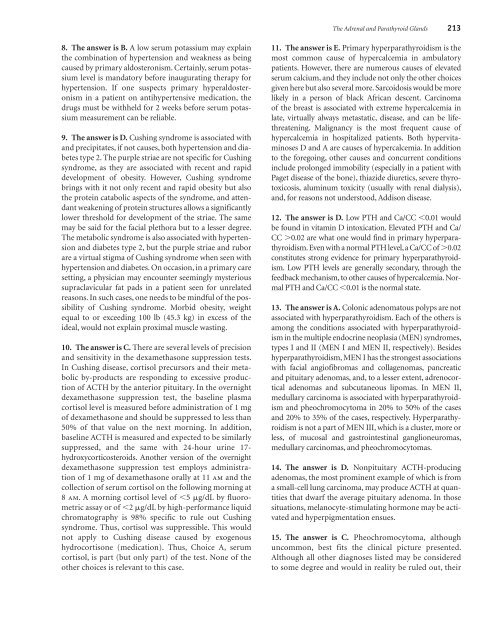NMS Q&A Family Medicine
NMS Q&A Family Medicine
NMS Q&A Family Medicine
- No tags were found...
Create successful ePaper yourself
Turn your PDF publications into a flip-book with our unique Google optimized e-Paper software.
The Adrenal and Parathyroid Glands 2138. The answer is B. A low serum potassium may explainthe combination of hypertension and weakness as beingcaused by primary aldosteronism. Certainly, serum potassiumlevel is mandatory before inaugurating therapy forhypertension. If one suspects primary hyperaldosteronismin a patient on antihypertensive medication, thedrugs must be withheld for 2 weeks before serum potassiummeasurement can be reliable.9. The answer is D. Cushing syndrome is associated withand precipitates, if not causes, both hypertension and diabetestype 2. The purple striae are not specific for Cushingsyndrome, as they are associated with recent and rapiddevelopment of obesity. However, Cushing syndromebrings with it not only recent and rapid obesity but alsothe protein catabolic aspects of the syndrome, and attendantweakening of protein structures allows a significantlylower threshold for development of the striae. The samemay be said for the facial plethora but to a lesser degree.The metabolic syndrome is also associated with hypertensionand diabetes type 2, but the purple striae and ruborare a virtual stigma of Cushing syndrome when seen withhypertension and diabetes. On occasion, in a primary caresetting, a physician may encounter seemingly mysterioussupraclavicular fat pads in a patient seen for unrelatedreasons. In such cases, one needs to be mindful of the possibilityof Cushing syndrome. Morbid obesity, weightequal to or exceeding 100 lb (45.3 kg) in excess of theideal, would not explain proximal muscle wasting.10. The answer is C. There are several levels of precisionand sensitivity in the dexamethasone suppression tests.In Cushing disease, cortisol precursors and their metabolicby-products are responding to excessive productionof ACTH by the anterior pituitary. In the overnightdexamethasone suppression test, the baseline plasmacortisol level is measured before administration of 1 mgof dexamethasone and should be suppressed to less than50% of that value on the next morning. In addition,baseline ACTH is measured and expected to be similarlysuppressed, and the same with 24-hour urine 17-hydroxycorticosteroids. Another version of the overnightdexamethasone suppression test employs administrationof 1 mg of dexamethasone orally at 11 am and thecollection of serum cortisol on the following morning at8 am . A morning cortisol level of 5 g/dL by fluorometricassay or of 2 g/dL by high-performance liquidchromatography is 98% specific to rule out Cushingsyndrome. Thus, cortisol was suppressible. This wouldnot apply to Cushing disease caused by exogenoushydrocortisone (medication). Thus, Choice A, serumcortisol, is part (but only part) of the test. None of theother choices is relevant to this case.11. The answer is E. Primary hyperparathyroidism is themost common cause of hypercalcemia in ambulatorypatients. However, there are numerous causes of elevatedserum calcium, and they include not only the other choicesgiven here but also several more. Sarcoidosis would be morelikely in a person of black African descent. Carcinomaof the breast is associated with extreme hypercalcemia inlate, virtually always metastatic, disease, and can be lifethreatening.Malignancy is the most frequent cause ofhypercalcemia in hospitalized patients. Both hypervitaminosesD and A are causes of hypercalcemia. In additionto the foregoing, other causes and concurrent conditionsinclude prolonged immobility (especially in a patient withPaget disease of the bone), thiazide diuretics, severe thyrotoxicosis,aluminum toxicity (usually with renal dialysis),and, for reasons not understood, Addison disease.12. The answer is D. Low PTH and Ca/CC 0.01 wouldbe found in vitamin D intoxication. Elevated PTH and Ca/CC 0.02 are what one would find in primary hyperparathyroidism.Even with a normal PTH level, a Ca/CC of 0.02constitutes strong evidence for primary hyperparathyroidism.Low PTH levels are generally secondary, through thefeedback mechanism, to other causes of hypercalcemia. NormalPTH and Ca/CC 0.01 is the normal state.13. The answer is A. Colonic adenomatous polyps are notassociated with hyperparathyroidism. Each of the others isamong the conditions associated with hyperparathyroidismin the multiple endocrine neoplasia (MEN) syndromes,types I and II (MEN I and MEN II, respectively). Besideshyperparathyroidism, MEN I has the strongest associationswith facial angiofibromas and collagenomas, pancreaticand pituitary adenomas, and, to a lesser extent, adrenocorticaladenomas and subcutaneous lipomas. In MEN II,medullary carcinoma is associated with hyperparathyroidismand pheochromocytoma in 20% to 50% of the casesand 20% to 35% of the cases, respectively. Hyperparathyroidismis not a part of MEN III, which is a cluster, more orless, of mucosal and gastrointestinal ganglioneuromas,medullary carcinomas, and pheochromocytomas.14. The answer is D. Nonpituitary ACTH-producingadenomas, the most prominent example of which is froma small-cell lung carcinoma, may produce ACTH at quantitiesthat dwarf the average pituitary adenoma. In thosesituations, melanocyte-stimulating hormone may be activatedand hyperpigmentation ensues.15. The answer is C. Pheochromocytoma, althoughuncommon, best fits the clinical picture presented.Although all other diagnoses listed may be consideredto some degree and would in reality be ruled out, their
















